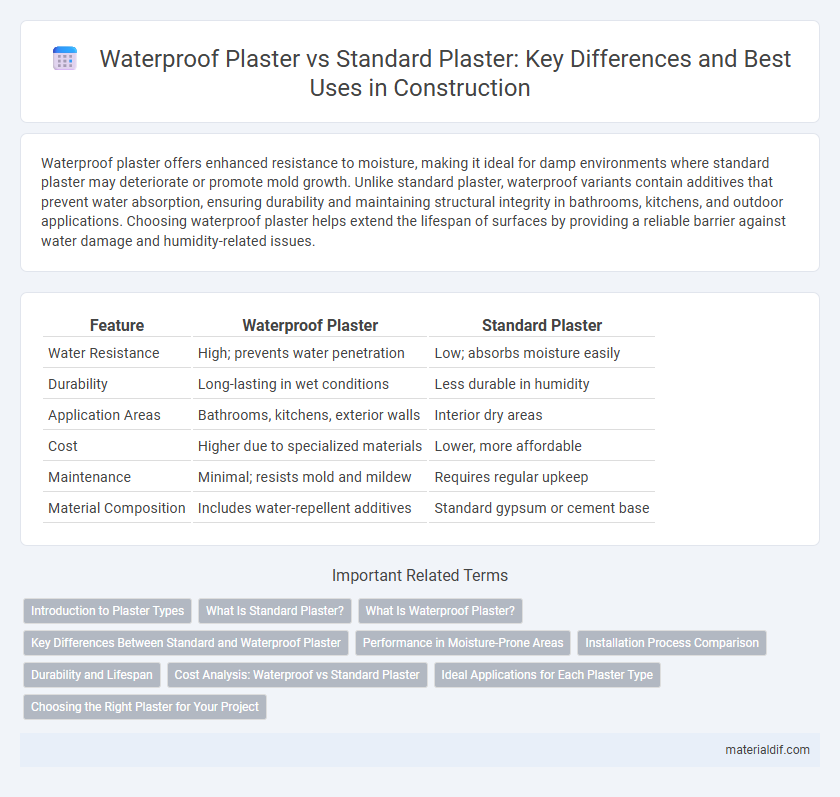Waterproof plaster offers enhanced resistance to moisture, making it ideal for damp environments where standard plaster may deteriorate or promote mold growth. Unlike standard plaster, waterproof variants contain additives that prevent water absorption, ensuring durability and maintaining structural integrity in bathrooms, kitchens, and outdoor applications. Choosing waterproof plaster helps extend the lifespan of surfaces by providing a reliable barrier against water damage and humidity-related issues.
Table of Comparison
| Feature | Waterproof Plaster | Standard Plaster |
|---|---|---|
| Water Resistance | High; prevents water penetration | Low; absorbs moisture easily |
| Durability | Long-lasting in wet conditions | Less durable in humidity |
| Application Areas | Bathrooms, kitchens, exterior walls | Interior dry areas |
| Cost | Higher due to specialized materials | Lower, more affordable |
| Maintenance | Minimal; resists mold and mildew | Requires regular upkeep |
| Material Composition | Includes water-repellent additives | Standard gypsum or cement base |
Introduction to Plaster Types
Waterproof plaster contains hydrophobic additives that prevent water penetration, making it ideal for damp environments or exterior surfaces exposed to moisture. Standard plaster, typically composed of gypsum or lime, provides a smooth finish but lacks water resistance, which can lead to deterioration in wet conditions. Choosing between waterproof and standard plaster depends on the application area's exposure to water and the required durability.
What Is Standard Plaster?
Standard plaster, commonly made from gypsum, lime, or cement, is a traditional building material used for coating walls and ceilings to create a smooth, decorative surface. It provides basic protection and durability but is susceptible to moisture damage, making it less ideal for wet or humid environments. Unlike waterproof plaster, standard plaster does not have water-resistant additives, which limits its effectiveness in preventing mold and deterioration caused by water exposure.
What Is Waterproof Plaster?
Waterproof plaster is a specialized plaster formulation designed to resist water penetration, making it ideal for damp or wet environments such as bathrooms and basements. Unlike standard plaster, which is porous and can absorb moisture leading to mold and structural damage, waterproof plaster contains additives like hydrophobic chemicals or polymer emulsions that enhance its water-resistant properties. This makes waterproof plaster a durable and protective choice for surfaces exposed to moisture, ensuring longevity and preventing water-related deterioration.
Key Differences Between Standard and Waterproof Plaster
Waterproof plaster incorporates water-resistant additives like acrylic or silicone polymers, enhancing its ability to prevent moisture penetration compared to standard plaster. Standard plaster, typically composed of gypsum or lime, offers good surface smoothness but lacks significant water resistance, making it unsuitable for damp areas. The key differences lie in waterproof plaster's enhanced durability and mold resistance, making it ideal for bathrooms and exterior walls, whereas standard plaster is primarily used for interior, dry environments.
Performance in Moisture-Prone Areas
Waterproof plaster offers superior resistance to moisture infiltration compared to standard plaster, making it highly suitable for damp or humid environments such as bathrooms and basements. Its formulation prevents water absorption, reducing the risk of mold growth and structural damage over time. Standard plaster, while effective in dry indoor areas, lacks the protective properties necessary for long-term durability in moisture-prone conditions.
Installation Process Comparison
Waterproof plaster requires a meticulous installation process involving the application of specialized water-resistant additives or membranes to create a moisture barrier, ensuring durability in damp environments. Standard plaster installation is simpler, typically involving a base coat and finishing layer without additional waterproofing measures, making it suitable for dry indoor applications. Proper surface preparation and curing time are critical for both types to achieve optimal adhesion and longevity.
Durability and Lifespan
Waterproof plaster offers superior durability compared to standard plaster due to its resistance to moisture, preventing cracks and mold growth in damp environments. Standard plaster typically has a shorter lifespan as it is more susceptible to water damage, leading to frequent repairs or replacement. Using waterproof plaster extends the longevity of walls in areas prone to humidity, ensuring structural integrity over time.
Cost Analysis: Waterproof vs Standard Plaster
Waterproof plaster generally costs 20-40% more than standard plaster due to specialized additives that enhance moisture resistance. Standard plaster is more affordable but may require frequent repairs or waterproofing treatments in humid environments, increasing long-term expenses. Investing in waterproof plaster reduces maintenance costs and protects structural integrity, justifying the higher upfront price.
Ideal Applications for Each Plaster Type
Waterproof plaster excels in high-moisture environments such as bathrooms, kitchens, and basements where resistance to water penetration and mold growth is critical. Standard plaster is suitable for dry indoor areas like living rooms, bedrooms, and hallways where moisture exposure is minimal, providing a smooth and durable finish. Choosing the right plaster type ensures optimal performance and longevity based on the room's humidity and functional requirements.
Choosing the Right Plaster for Your Project
Waterproof plaster offers enhanced resistance against moisture, making it ideal for humid environments such as bathrooms and kitchens, whereas standard plaster is suitable for dry, interior walls. Selecting the right plaster depends on the specific conditions of your project, including exposure to water, durability requirements, and intended finish. For projects prone to dampness or water exposure, waterproof plaster ensures longevity and prevents mold growth, making it the optimal choice.
Waterproof Plaster vs Standard Plaster Infographic

 materialdif.com
materialdif.com